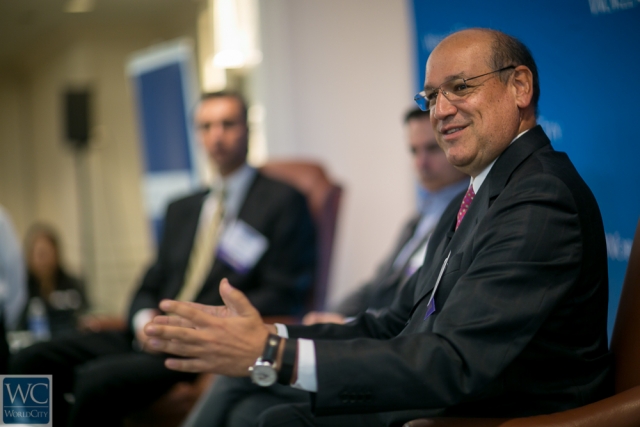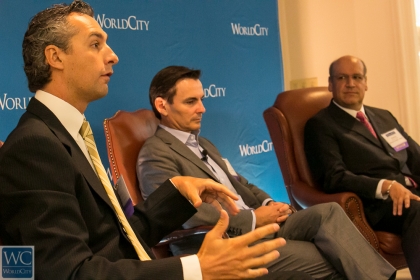Innovation in health care: Tech boosts access, but who pays?

Innovation in health care is zooming ahead, borne on the wings of new technologies from real-time telecommunications to cloud storage and wearable, self-monitoring devices.
But providing health care for a growing population and figuring out how to pay for it will be massive challenges in the years ahead – both for Latin America and the entire world.
Addressing those issues at WorldCity’s Global Connections event June 26 were three health care executives focused on Latin America: Mauricio Ortiz, vice president for Latin America at Boston Scientific; Fabrice Chouraqui, head of Latin America and the Caribbean for Novartis Pharmaceuticals; and Guillaume Corpart, founder of consulting firm Global Health Intelligence.
Is Latin America easier or more difficult to operate in than the rest of the world?, WorldCity CEO Ken Roberts asked the panelists.

Guillaume Corpart, founder of consulting firm Global Health Intelligence.
“I think you have to recognize that the economic boom in Latin America is over,” said Novartis’ Chouraqui, referring to slowing growth regionwide. Yet governments face rising pressure to deliver quality health care – as citizens learn through the internet of care commonly available elsewhere.
“Easier,” said Ortiz, who is pictured above. A growing population and middle class in Latin America mean growing demand for Boston Scientific’s medical devices and monitoring systems. “Easier sounds like it’s easy, but it’s not.”
Some opportunities are unique to Latin America, added consultant Corpart. For example, the region has 18,000 hospitals, compared to 15,000 in Europe and 5,800 in the United States. But the hospitals tend to be small, and no company has a monopoly on them. “The global player has to adapt to the distribution structure and understand the market,” said Corpart, “because it is a completely different landscape.”
Telemedicine: Expanding access to health care
How can new technologies like telemedicine boost access to health care?, asked Monica Chiarini Tremblay, who chairs the Department of Decision Sciences & Information Systems at Florida International University’s College of Business.
In some ways, practices developing in Latin America are forerunners of global trends. For instance, one program in Mexico lets patients and doctors connect by video-phone service Facetime, said Ortiz.
Technology is “the backbone of all we are talking about,” said Corpart, pointing to health care innovations from mobile phones to electronic medical records.

Fabrice Chouraqui, head of Latin America and the Caribbean for Novartis Pharmaceuticals
The big question is how tech will influence payments. “I think we need to listen to payers,” said Chouraqui. “What sort of end-points matter to payers? I think that is the future.” Already, digital records provide insurance companies, governments and other payers with better tools for evaluation.
“Payers don’t want to see data trials, they want to see data that is real – local data in single clinics that show the value of treatment,” said Choraqui.
Paying the bill for new technologies
Audience members had plenty of questions.
“It’s great to have technology and low-cost alternatives for people who don’t have access, but are payers keeping up with you, and are they willing to reimburse for the technology being created?,” asked Lawrence Carter, senior managing director of Global Healthcare Advisors LLC.
Replied Ortiz, “There will never be a time when everybody catches up with technology.”
How do service providers come into the picture?, asked Victoria Lopez Lozano, director IT services in the Business Unit of Telefonica USA. “What do you expect of the Internet?”
The internet holds promise to bring health care to greater numbers of people, panelists agreed.
Still, the cost of new – and expensive – technology brings up the issue of access to cutting edge treatments for the wealthy, while a great swath of humanity still struggles to obtain basic care.
Most visibly, some people are now buying (and companies investing in) increasingly sophisticated wearable devices that measure blood pressure, heart rate and other bio-data. “I think what is really exciting for all of us will be in the wearable part and the digital part,” Ortiz said.

Victoria Lopez Lozano, director IT services in the Business Unit of Telefonica USA.
Those devices and other technology can aggregate new data with existing medical information for predictive and other uses. At some point, companies will be able to employ algorithms to foresee the incidence of specific health conditions, perhaps even by zip code.
The economics of prevention vs. treatment
But is there money to be made in prevention?, asked Alfredo Blumenthal, an executive in sales management and business development at WB Engineering.
“We will all suffer from something – and medicine will get more sophisticated,” said Ortiz. The question is whether the costs of preventive care and early-detection tests outweigh the savings obtained from catching diseases early. “When does prevention and detection play against the payer?”

Alfredo Blumenthal, an executive in sales management and business development at WB Engineering.
That’s key, because the world’s population is slated to rise by about 1 billion over the next decade – and with it, the portion over 50 years old who are more likely to need treatment. “Whose risk is it – the individual, the government?,” asked Chouraqui. “We have an emerging time bomb in front of us.”
Global Connections is one of five event series offered by WorldCity to bring together executives in greater Miami on international business topics. The Global series is sponsored by FIU and public relations giant Edelman.
The next Global Connections event is set for July 31.
